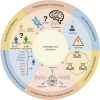γ neuromodulations: unraveling biomarkers for neurological and psychiatric disorders
- PMID: 40571935
- PMCID: PMC12203730
- DOI: 10.1186/s40779-025-00619-x
γ neuromodulations: unraveling biomarkers for neurological and psychiatric disorders
Abstract
γ neuromodulation has emerged as a promising strategy for addressing neurological and psychiatric disorders, particularly in regulating executive and cognitive functions. This review explores the latest neuromodulation techniques, focusing on the critical role of γ oscillations in various brain disorders. Direct γ neuromodulation induces γ-frequency oscillations to synchronize disrupted brain networks, while indirect methods influence γ oscillations by modulating cortical excitability. We investigate how monitoring dynamic features of γ oscillations allows for detailed evaluations of neuromodulation effectiveness. By targeting γ oscillatory patterns and restoring healthy cross-frequency coupling, interventions may alleviate cognitive and behavioral symptoms linked to disrupted communication. This review examines clinical applications of γ neuromodulations, including enhancing cognitive function through 40 Hz multisensory stimulation in Alzheimer's disease, improving motor function in Parkinson's disease, controlling seizures in epilepsy, and modulating emotional dysfunctions in depression. Additionally, these neuromodulation strategies aim to regulate excitatory-inhibitory imbalances and restore γ synchrony across neurological and psychiatric disorders. The review highlights the potential of γ oscillations as biomarkers to boost restorative results in clinical applications of neuromodulation. Future studies might focus on integrating multimodal personalized protocols, artificial intelligence (AI) driven frameworks for neural decoding, and global multicenter collaborations to standardize and scale precision treatments across diverse disorders.
Keywords: Cross frequency coupling; Deep brain stimulation (DBS); Neurological disorders; Neuromodulation; Psychiatric disorders; Transcranial magnetic stimulation (TMS); γ oscillations.
© 2025. The Author(s).
Conflict of interest statement
Declarations. Ethics approval and consent to participate: Not applicable. Consent for publication: Not applicable. Competing interests: All authors declare that they have no competing interest.
Figures





Similar articles
-
Modulation of Cerebellar Oscillations with Subthalamic Stimulation in Patients with Parkinson's Disease.J Parkinsons Dis. 2024;14(7):1417-1426. doi: 10.3233/JPD-240065. J Parkinsons Dis. 2024. PMID: 39331106 Free PMC article.
-
High-definition transcranial direct-current stimulation of left primary motor cortices modulates beta and gamma oscillations serving motor control.J Physiol. 2025 Mar;603(6):1627-1644. doi: 10.1113/JP287085. Epub 2025 Feb 26. J Physiol. 2025. PMID: 40009440
-
Erasing "bad memories": reversing aberrant synaptic plasticity as therapy for neurological and psychiatric disorders.Mol Psychiatry. 2025 Jul;30(7):3209-3225. doi: 10.1038/s41380-025-03013-0. Epub 2025 Apr 10. Mol Psychiatry. 2025. PMID: 40210977 Free PMC article. Review.
-
Enhancing the diagnostic potential of electroretinography in Parkinson's disease: A review of protocol and cohort criteria.J Parkinsons Dis. 2025 Jun;15(4):694-709. doi: 10.1177/1877718X251331863. Epub 2025 Apr 29. J Parkinsons Dis. 2025. PMID: 40530583 Review.
-
Probing responses to deep brain stimulation with functional magnetic resonance imaging.Brain Stimul. 2022 May-Jun;15(3):683-694. doi: 10.1016/j.brs.2022.03.009. Epub 2022 Apr 18. Brain Stimul. 2022. PMID: 35447378
References
-
- Temel Y, Hescham SA, Jahanshahi A, Janssen ML, Tan SK, van Overbeeke JJ, et al. Neuromodulation in psychiatric disorders. Int Rev Neurobiol. 2012;107:283–314. - PubMed
-
- Edwards CA, Kouzani A, Lee KH, Ross EK. Neurostimulation devices for the treatment of neurologic disorders. Mayo Clin Proc. 2017;92(9):1427–44. - PubMed
-
- Conroy SK, Holtzheimer PE. Neuromodulation strategies for the treatment of depression. Am J Psychiatry. 2021;178(12):1082–8. - PubMed
Publication types
MeSH terms
Substances
Grants and funding
LinkOut - more resources
Full Text Sources
Medical

